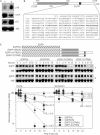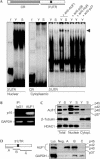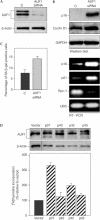Increased stability of the p16 mRNA with replicative senescence
- PMID: 15678155
- PMCID: PMC1299256
- DOI: 10.1038/sj.embor.7400346
Increased stability of the p16 mRNA with replicative senescence
Abstract
Expression of p16(INK4a) is elevated during ageing and replicative senescence. Here, we report the presence of an instability determinant within the 3'-untranslated region (UTR) of the p16 messenger RNA in WI-38 human diploid fibroblasts. The p16 3'UTR was found to be a specific target of AUF1, an RNA-binding protein implicated in promoting mRNA decay. Both AUF1 levels and AUF1-p16 mRNA associations were strikingly more abundant in early-passage than late-passage fibroblast cultures. Moreover, short interfering RNA-based reductions in AUF1 levels increased the stability of p16 3'UTR-containing transcripts, elevated the expression of p16 and accentuated the senescence phenotype. Together, our findings show that p16 mRNA turnover decreases during replicative senescence and that the instability-conferring region is located within the 3'UTR of p16, as well as identifying AUF1 as a critical mediator of these regulatory events.
Figures




Similar articles
-
Hydrogen peroxide induces p16(INK4a) through an AUF1-dependent manner.J Cell Biochem. 2010 Apr 1;109(5):1000-5. doi: 10.1002/jcb.22474. J Cell Biochem. 2010. PMID: 20069554
-
p16( INK4a) positively regulates cyclin D1 and E2F1 through negative control of AUF1.PLoS One. 2011;6(7):e21111. doi: 10.1371/journal.pone.0021111. Epub 2011 Jul 20. PLoS One. 2011. PMID: 21799732 Free PMC article.
-
The tRNA methyltransferase NSun2 stabilizes p16INK⁴ mRNA by methylating the 3'-untranslated region of p16.Nat Commun. 2012 Mar 6;3:712. doi: 10.1038/ncomms1692. Nat Commun. 2012. PMID: 22395603 Free PMC article.
-
Physiological networks and disease functions of RNA-binding protein AUF1.Wiley Interdiscip Rev RNA. 2014 Jul-Aug;5(4):549-64. doi: 10.1002/wrna.1230. Epub 2014 Mar 28. Wiley Interdiscip Rev RNA. 2014. PMID: 24687816 Review.
-
AUF1 regulation of coding and noncoding RNA.Wiley Interdiscip Rev RNA. 2017 Mar;8(2):10.1002/wrna.1393. doi: 10.1002/wrna.1393. Epub 2016 Sep 13. Wiley Interdiscip Rev RNA. 2017. PMID: 27620010 Free PMC article. Review.
Cited by
-
Tissue- and age-dependent expression of RNA-binding proteins that influence mRNA turnover and translation.Aging (Albany NY). 2009 Jul 26;1(8):681-98. doi: 10.18632/aging.100073. Aging (Albany NY). 2009. PMID: 20157551 Free PMC article.
-
The inflammatory/cancer-related IL-6/STAT3/NF-κB positive feedback loop includes AUF1 and maintains the active state of breast myofibroblasts.Oncotarget. 2016 Jul 5;7(27):41974-41985. doi: 10.18632/oncotarget.9633. Oncotarget. 2016. PMID: 27248826 Free PMC article.
-
Interleukin-8 Dedifferentiates Primary Human Luminal Cells to Multipotent Stem Cells.Mol Cell Biol. 2020 Apr 13;40(9):e00508-19. doi: 10.1128/MCB.00508-19. Print 2020 Apr 13. Mol Cell Biol. 2020. PMID: 32015100 Free PMC article.
-
Clinical and functional significance of tumor/stromal ATR expression in breast cancer patients.Breast Cancer Res. 2020 May 15;22(1):49. doi: 10.1186/s13058-020-01289-4. Breast Cancer Res. 2020. PMID: 32414408 Free PMC article.
-
CSIG inhibits PTEN translation in replicative senescence.Mol Cell Biol. 2008 Oct;28(20):6290-301. doi: 10.1128/MCB.00142-08. Epub 2008 Aug 4. Mol Cell Biol. 2008. PMID: 18678645 Free PMC article.
References
-
- Brewer G (2002) Messenger RNA decay during aging and development. Ageing Res Rev 1: 607–625 - PubMed
-
- Campisi J (1997) The biology of replicative senescence. Eur J Cancer 33: 703–709 - PubMed
-
- Chen CY et al. (2001) AU-binding proteins recruit the exosome to degrade ARE-containing mRNAs. Cell 107: 451–464 - PubMed
-
- Cristofalo VJ, Volker C, Francis MK, Tresini M (1998) Age-dependent modifications of gene expression in human fibroblasts. Crit Rev Eukaryot Gene Expression 8: 43–80 - PubMed
MeSH terms
Substances
Grants and funding
LinkOut - more resources
Full Text Sources
Research Materials

